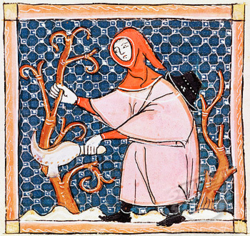History
The origins of the billhook probably lie in the pruning hooks used in the gardens and vineyards of the Assyrians in ancient Mesopotamia, the ancient centre of civilisation that lay on the fertile plains (the Garden of Eden??) between the Tigris and the Euphrates rivers in what is now modern Iran and Iraq.
The earliest written mentions are in the books of the Old Testament from c 800BC, and the writings of the Greek, Hessiod c 700BC. Examples in bronze dating to about 1000BC have been found in Egypt, so they are likely to have been in common usage for over 3000 years. With the Assyrians they spread eastwards into India and Asia, and westwards to the Mediterranean where the Egyptians, and later the Greeks, took them to their colonies across the north of Africa and the south of Europe.
Early tools were probably cast, and later forged in bronze and as few examples survive (compared to the vast numbers of bronze sickles and axe heads that have been found) they were probably restricted to light horticutural and vinicultural pruning. The advent of the Iron Age (c 1000 BC) allowed the development of larger and stronger types, and by the time of the Roman invasions of Britain, circa AD50, they were in common use through most of Western and Central Europe, including Britain. With the Romans they spread throughout the rest of Central and into Northern Europe.
Examples of pre-Roman and Romano-British billhooks have been found in England and many European countries, and they have been in continual usage ever since. The Roman author, Cato, describes in detail the various tools used in agriculture and mentions four different kinds of 'falx':
- those for use in a vineyard,
- those for cutting rushes,
- those for pruning trees,
- those for cutting briars,
and in addition grape harvesting and broom cutting sickles, 'falcula' or small falx.
Another author, Columella, mentions in detail the parts of a vineyard hook, but sadly no illustations have survived, and no extant examples of Roman period pruning hooks exactly match the descriptions.
One of the problens with accurately describing edge tools is that translators of Ancient Greek and Latin text were not familiar with the tools they were describing, and 2000 years of translations have left gaps in our knowledge. The Latin for vine pruning hook is variously given as 'Falx Vinitoria'; 'Falce Vineatica' or 'Falcis Vineaticae' - which to the Latin scholar probably makes sense but to a Google search engine....??

